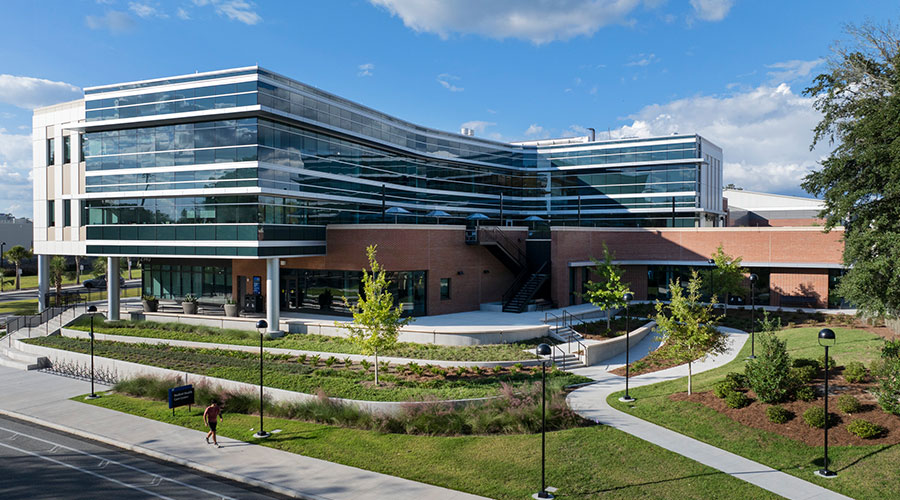Green Infrastructure: Popular Examples and Emerging Trends
Finding co-Benefits make it easier to adopt green infrastructure initiatives.
By Dave Lubach, managing editor
Green roofing. Stormwater management. Municipal infrastructure. All of these are phrases that can be lumped into a discussion of green infrastructure.
One of the challenges facility managers face today is trying to incorporate their buildings’ surroundings into the efficient operation of institutional and commercial facilities. This includes providing more access to green space and connecting with public transportation to help reduce vehicles on the road.
Anjulie Palta, an associate with New York-based architecture and urban design firm Cooper Robertson, talked about green infrastructure with Facilitiesnet.com and offered managers some tips on how to move forward with projects at their own facilities.
Here is the conversation, edited for length.
FN: Is the concept of green infrastructure a fairly new concept for institutional and commercial facilities?
Anjulie Palta: I think it’s fairly new, in terms of looking at systems management like MEP (mechanical, electrical and plumbing systems) and utility systems for larger institutions, just the technology in the last 10-15 years. The technology is constantly changing, and I think it’s become a lot greener recently. However, I think in terms of landscape and site design, things like stormwater management, green capture system detention like reservoirs, those have always been a part of institutional growth and site design.
FN: Do you find that most institutions are willing participants in these kinds of things, such as sustainability and addressing climate change?
AP: Absolutely. I think institutions are really taking a critical look at their internal missions and goals and sort of this larger imperative to address public health. It feels like with a medical institution in particular, there’s some real kind of synergies with that kind of mission. And it’s kind of imperative for larger health issues, which dovetails with green infrastructure, planning and what green infrastructure can provide in terms of reducing particulate matter in the atmosphere, such as providing flood resilience to vulnerable communities. But there is a huge challenge. I think the institutions are really interested in green infrastructure and future planning. But I think it’s really difficult because large institutions, ones that may even have multiple facilities or buildings, have really large footprints or huge land holdings. Buildings that might have been built at different times may have varying MEP and operational systems. So, for them, it really kind of has to be a more surgical approach rather than kind of wholesale holistic changes at a kind of campus-wide or institutional level. It takes some real strategic planning to think about how to upgrade a building to be able to hold a green roof or redo the landscaping in front of a hospital building. It requires more long-term planning, especially if the institution or facility needs to remain operational while physical changes are made.
FN: Is there sometimes a need for a change in mentality among facility leaders to approach these kinds of green landscape projects?
AP: I’m more of an expert on the medical institution side and hospital side of facilities, and I think it’s really critical that medical institutions really understand how much energy they consume, and their impact on climate change and how that can be addressed through green infrastructure programs and fiscal interventions. Studies have shown that hospitals consume nearly twice as much energy than an average commercial building, which is a huge hurdle in itself. I think any facilities manager who really thinks about that is kind of overwhelmed by the prospect of needing to address that, but it’s something that I think these institutions have to contend with and really understand. I think there’s also a fear that there won’t be a return on investment. A lot of green infrastructure projects can be large, and they require a lot of upfront cost. Realizing how green infrastructure can pay off in the long term, understanding that there will be significant costs, cost savings over the long term, related primarily to energy consumption, is a huge operational shift in a lot of ways.
FN: Through your experiences, what are some of the more popular examples of green infrastructure with your clients?
AP: I would say green roofs are definitely popular, especially habitable ones. (Green infrastructure) is kind of about finding opportunities where there are multiple benefits. Green roofs can slow down rainwater and harvest rainwater, but it could also be a place for patients or visitors or staff to have access to green space. I think the green infrastructure that can allow for multiple benefits is something that’s been a popular approach. Stormwater management as a re-landscaping approach to grounds is another popular invention, which looks at how to think about rain catchment and detention, but also provides an opportunity to redesign open space for users.
FN: What are some emerging trends in the green infrastructure field?
AP: I would say this isn’t something I think most people think of when they think of green infrastructure, but as an urban designer I definitely do, and that’s access to infrastructure to support multimodal transit. That’s looking kind of beyond the sight boundaries of the facility or actual building into existing multimodal transit opportunities and networks, which really can mean decreasing parking needs for an institution and encouraging transit use for employees and visitors, and kind of leveraging existing municipal infrastructure, municipal green infrastructure for an institution, which I think is really interesting and is really, really effective in terms of reducing carbon emissions and impacts the general footprint of these institutions.
FN: Programs like multimodal transit require working with local governments to make them happen. What are some strategies to consider when working with local governments?
AP: Looking at existing green infrastructure programs that the city or state might fund or give tax incentives is really important. Beyond keying into their networks, looking at the kind of funding avenues that could be provided by the city is a way to leverage that partnership.
FN: What kind of advice do you have for a facility manager who wants to either start or expand a green infrastructure program?
AP: I would suggest starting at a high level, assessing your open space, including your roofs, where appropriate. Look for areas and opportunities that might provide co-benefits. For example, how can an existing, underutilized open space on an institution’s campus or ground serve both visitors or patients in the case of a health institution. Look at the social capital of an organization while providing some kind of stormwater management component, and how can the two work together. I think finding those co-benefits makes the case stronger for implementing a lot of green infrastructure. I guess I would also say again, look at your larger context, like what are the existing green spaces beyond your borders that you can key into like existing transit networks. Think big in that way and work backwards from there. Looking for opportunities to collaborate with local governments and partners is key.
Dave Lubach is the managing editor, Facility Markets. He has more than six years of experience writing about facility management issues.
Related Topics:












